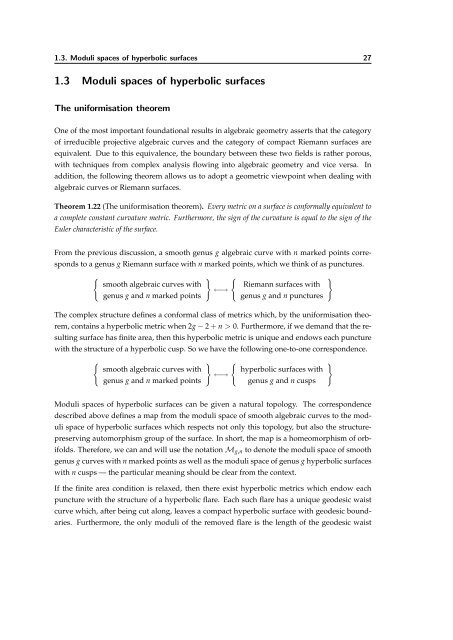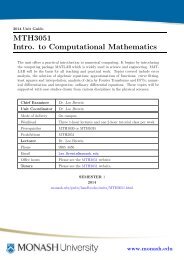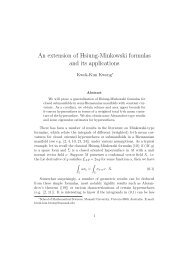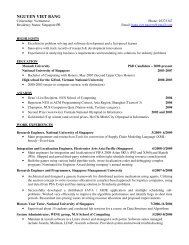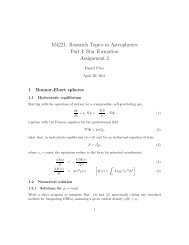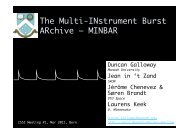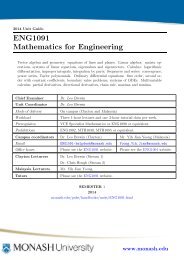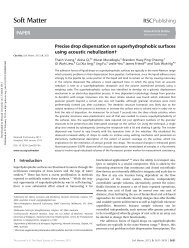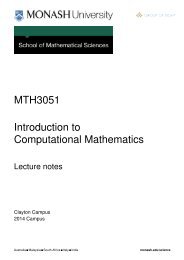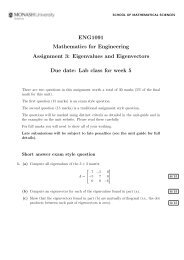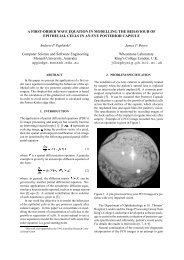Intersection theory on moduli spaces of curves ... - User Web Pages
Intersection theory on moduli spaces of curves ... - User Web Pages
Intersection theory on moduli spaces of curves ... - User Web Pages
You also want an ePaper? Increase the reach of your titles
YUMPU automatically turns print PDFs into web optimized ePapers that Google loves.
1.3. Moduli <strong>spaces</strong> <strong>of</strong> hyperbolic surfaces 271.3 Moduli <strong>spaces</strong> <strong>of</strong> hyperbolic surfacesThe uniformisati<strong>on</strong> theoremOne <strong>of</strong> the most important foundati<strong>on</strong>al results in algebraic geometry asserts that the category<strong>of</strong> irreducible projective algebraic <strong>curves</strong> and the category <strong>of</strong> compact Riemann surfaces areequivalent. Due to this equivalence, the boundary between these two fields is rather porous,with techniques from complex analysis flowing into algebraic geometry and vice versa. Inadditi<strong>on</strong>, the following theorem allows us to adopt a geometric viewpoint when dealing withalgebraic <strong>curves</strong> or Riemann surfaces.Theorem 1.22 (The uniformisati<strong>on</strong> theorem). Every metric <strong>on</strong> a surface is c<strong>on</strong>formally equivalent toa complete c<strong>on</strong>stant curvature metric. Furthermore, the sign <strong>of</strong> the curvature is equal to the sign <strong>of</strong> theEuler characteristic <strong>of</strong> the surface.From the previous discussi<strong>on</strong>, a smooth genus g algebraic curve with n marked points corresp<strong>on</strong>dsto a genus g Riemann surface with n marked points, which we think <strong>of</strong> as punctures.{} {smooth algebraic <strong>curves</strong> with←→genus g and n marked points}Riemann surfaces withgenus g and n puncturesThe complex structure defines a c<strong>on</strong>formal class <strong>of</strong> metrics which, by the uniformisati<strong>on</strong> theorem,c<strong>on</strong>tains a hyperbolic metric when 2g − 2 + n > 0. Furthermore, if we demand that the resultingsurface has finite area, then this hyperbolic metric is unique and endows each puncturewith the structure <strong>of</strong> a hyperbolic cusp. So we have the following <strong>on</strong>e-to-<strong>on</strong>e corresp<strong>on</strong>dence.{} {}smooth algebraic <strong>curves</strong> withhyperbolic surfaces with←→genus g and n marked pointsgenus g and n cuspsModuli <strong>spaces</strong> <strong>of</strong> hyperbolic surfaces can be given a natural topology. The corresp<strong>on</strong>dencedescribed above defines a map from the <strong>moduli</strong> space <strong>of</strong> smooth algebraic <strong>curves</strong> to the <strong>moduli</strong>space <strong>of</strong> hyperbolic surfaces which respects not <strong>on</strong>ly this topology, but also the structurepreservingautomorphism group <strong>of</strong> the surface. In short, the map is a homeomorphism <strong>of</strong> orbifolds.Therefore, we can and will use the notati<strong>on</strong> M g,n to denote the <strong>moduli</strong> space <strong>of</strong> smoothgenus g <strong>curves</strong> with n marked points as well as the <strong>moduli</strong> space <strong>of</strong> genus g hyperbolic surfaceswith n cusps — the particular meaning should be clear from the c<strong>on</strong>text.If the finite area c<strong>on</strong>diti<strong>on</strong> is relaxed, then there exist hyperbolic metrics which endow eachpuncture with the structure <strong>of</strong> a hyperbolic flare. Each such flare has a unique geodesic waistcurve which, after being cut al<strong>on</strong>g, leaves a compact hyperbolic surface with geodesic boundaries.Furthermore, the <strong>on</strong>ly <strong>moduli</strong> <strong>of</strong> the removed flare is the length <strong>of</strong> the geodesic waist


